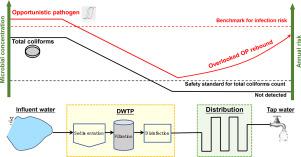Ecological Engineering ( IF 3.9 ) Pub Date : 2021-01-05 , DOI: 10.1016/j.ecoleng.2020.106134 Jingang Huang , Susu Chen , Xu Ma , Pingfeng Yu , Pengxiao Zuo , Baoyou Shi , Haibo Wang , Pedro J.J. Alvarez

|
This study investigated the occurrence of various opportunistic pathogens (OPs) through four drinking water treatment and distribution systems in eastern China. Conventional treatment trains involving coagulation/sedimentation, filtration, and disinfection efficiently removed total coliforms from 1700 to 2300 CFU/L in the influent to undetectable levels in treated and tap water. However, culture-independent qPCR analysis detected Legionella spp., Mycobacterium spp., Mycobacteria avium, Pseudomonas aeruginosa and the amoeba Acanthamoeba spp. in all water samples, reaching maximum tap water concentrations of 5.33, 4.87, 1.63, 3.85, and 4.32 log (gene copies/mL), respectively. Thus, OPs were abundant in tap water despite total coliforms met applicable microbiological standards in China (GB 5749–2006). Occurrence of OPs correlated positively with turbidity and chemical oxygen demand (COD), and negatively with chlorine residual. Turbidity removal by coagulation and COD removal by ozonation (O3) followed by biological activated carbon (BAC) filtration was the treatment train with the highest OPs removal efficiency, and ClO2 was a more effective disinfectant than NaClO. OPs significantly rebounded in the tap water (up to 11-fold for P. aeruginosa and 21-fold for M. avium in tap water). However, quantitative microbial risk analysis (QMRA) showed that the potential infection risks in tap water were still below WHO (10−3) and even EPA (10−4) benchmarks. Overall, likely underestimation of the pathogenic risk by culture-dependent quantification of indicator organisms makes it prudent to use molecular approaches to periodically revisit the safety of water distribution systems.











































 京公网安备 11010802027423号
京公网安备 11010802027423号